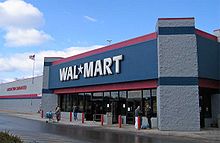- Discount store
-
 A typical Wal-Mart discount department store.
A typical Wal-Mart discount department store.
A discount store is a type of department store, which sells products at prices lower than those asked by traditional retail outlets. Most discount department stores offer a wide assortment of goods; others specialize in such merchandise as jewelry, electronic equipment, or electrical appliances. Discount stores are not variety stores, which sell goods at a single price-point or multiples thereof (£1, $2, etc.). Discount stores differ from variety stores in that they sell many name-brand products, and because of the wide price range of the items offered. Following World War II, a number of retail establishments in the U.S. began to pursue a high-volume, low-profit-margin strategy designed to attract price-conscious consumers.[citation needed]
Currently Wal-Mart, the largest retailer in the world, operates more than 1,300 discount stores in the U.S. Target and Kmart are Wal-Mart's top competitors. Wal-Mart as of 2004, owns 90% of the Asda chain of supermarkets in the UK. As of 2008, the main rival to Asda is Tesco.
Contents
History
During the period from the 1950s to the late 1980s, discount stores were more popular than the average supermarket or department store in the United States. There were hundreds of discount stores in operation, with their most successful period occurring during the mid-1960s in the U.S. with discount store chains such as Kmart, Ames, E. J. Korvette, Fisher's Big Wheel, Zayre, Bradlees, Caldor, Jamesway Howard Brothers Discount Stores, Kuhn's-Big K (sold to Wal-Mart in 1981), TG&Y and Woolco (closed in 1983, part sold to Wal-Mart) among others.[citation needed]
Wal-Mart, Kmart, and Target all opened their first locations in 1962. Other retail companies branched out into the discount store business around that time as adjuncts to their older store concepts. As examples, Woolworth opened a Woolco chain (also in 1962); Montgomery Ward opened Jefferson Ward; Chicago-based Jewel launched Turn Style; and Central Indiana-based L. S. Ayres created Ayr-Way. J.C. Penney opened discount stores called Treasure Island or The Treasury, and Atlanta-based Rich's owned discount stores called Richway. During the late 1970s and the 1980s, these chains typically were either shut down or sold to a larger competitor. Kmart and Target themselves are examples of adjuncts, although their growth prompted their respective parent companies to abandon their older concepts (the S.S. Kresge five and dime store disappeared, while the Dayton-Hudson Corporation eventually divested itself of its department store holdings and renamed itself Target Corporation).[citation needed]
In the United States, discount stores had 42% of overall retail market share in 1987; in 2010, they had 87%.[1]
Many of the major discounters now operate "supercenters", which add a full-service grocery store to the traditional format. The Meijer chain in the Midwest consists entirely of supercenters, while Wal-Mart and Target have focused on the format as of the 1990s as a key to their continued growth. Although discount stores and department stores have different retailing goals and different markets, a recent development in retailing is the "discount department store", such as Sears Essentials, which is a combination of the Kmart and Sears formats, following the companies' merger as Sears Holdings Corporation.
Japan
Japan has numerous discount stores, including Costco, and Mr Max.
See also
References
- '^ "America's top stores." Consumer Reports, June 2010, p. 17.
Further reading
Nelson, Walter Henry, The Great Discount Delusion, New York: D. McKay, 1965.
Categories:- Retailing
- Discount stores
Wikimedia Foundation. 2010.
